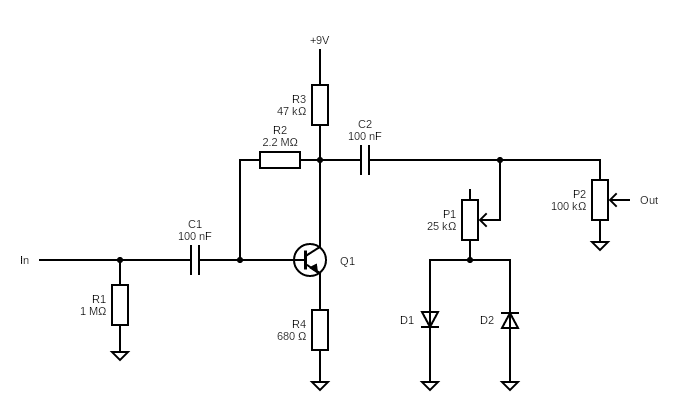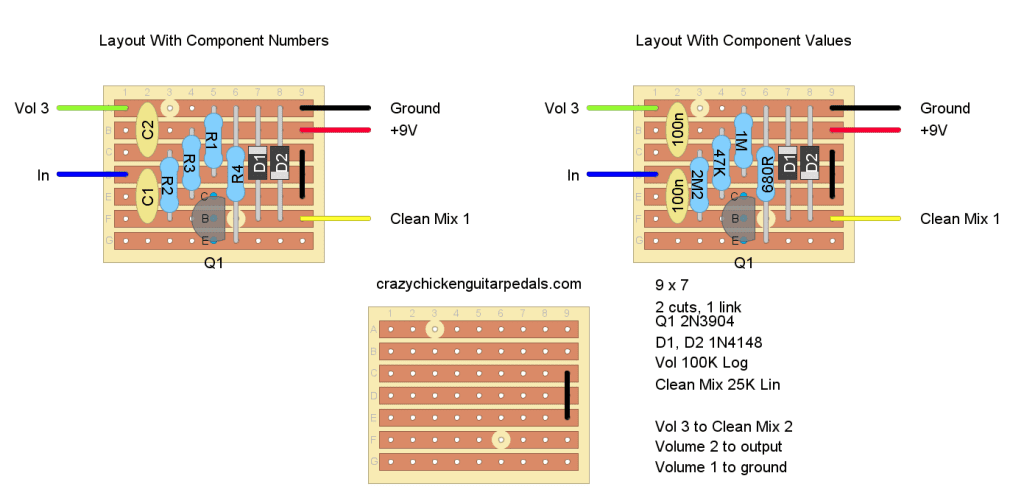Here’s a kind of weird guitar pedal, but a fun build nonetheless and also a pretty simple guitar pedal build too.
I had never heard of the Green Giant by Greer Amps before and I kind of just stumbled upon the layout on Tagboard Effects and thought it sounded interesting. Other than what’s on Tagboard Effects, I can’t find any more information on this pedal. Everyone else on the internet appears to have the same brief description of the pedal that you see at Tagboard Effects. The Greer website doesn’t even have any information on the pedal.
What I do know from the brief description that’s repeated across the internet is that the Green Giant was never a production pedal. Instead it was only built for “endorsers.” I assume that these were artists who had some sort of endorsement relationship with Greet Amps. The Green Giant is a modification of Greer Amps’ existing Black Fuzz pedal, which in itself is just a modified Electra Distortion circuit, which is a very popular starting point for a lot of fuzz, distortion, and overdrive circuits, the Lovepedal Champ being one of them.
The big difference with the Green Giant when compared to Greer Amps’ Black Fuzz is the introduction of the blend dial. This affects how much the signal is getting clipped by the clipping diodes and how much clean signal is getting through. Rather than just giving levels of distortion from “not so distorted” up to “very distorted,” the blend knob on the Green Giant allows some clean signal through while also allowing some distorted signal through. So it’s not just levels, it’s a mixture of clean and dirty signals.
I did manage to use the Wayback Machine to find a product listing from 2016 for this pedal on the Greer website, but it didn’t offer much more information than what I had already seen.For whatever reason Greer decided to discontinue this pedal and it hasn’t been talked about very much.
Greer Amps Green Giant Wiring Schematic
I’ll jump into the stripboard layout later in the article, but below is the wiring schematic for the Green Giant. As mentioned in the intro to this article, there’s not a lot of information on this pedal out there, and I could only find one source on the schematic. I compared this to the stripboard layout and there were a couple minor differences, but I think I’ve managed to piece everything together into something that at least resembles the original schematic. Unfortunately this isn’t readily verifiable information.
With a lot of these pedals I can often find original information on the schematic or at least enough sources to verify it. In this case, I couldn’t, but I do know the schematic (and the stripboard layout below) works! So if you like this pedal build, it may not be the exact way it was done by Greer Amps, but it’s also probably close enough.
Here’s the wiring diagram:
Click on the schematic to enlarge it.
And here’s the bill of materials.
| Notes | ||
|---|---|---|
| R1 | 1M | |
| R2 | 2.2M | |
| R3 | 47K | |
| R4 | 680R | |
| C1 | 100nF | |
| C2 | 100nF | |
| Q1 | 2N3904 | |
| P1 | 25K Lin | Clean mix potentiometer |
| P2 | 100K Log | Volume potentiometer |
| D1, D2 | 1N4148 | |
| Jacks, power supply, etc. | Don't Forget | The stuff you usually use. |
Yep, it’s clearly an Electra Distortion, but that’s OK, it’s the circuit that just keeps on giving!
The obvious addition here is the potentiometer wired in just before the clipping diodes. As mentioned, this is regulating how much dirty signal gets through, blending everything with the clean signal. When this pot is giving no resistance, you get a dirtier signal; lots of resistance and you get less dirt that’s mixed in with the clean.
What’s really interesting here is that this potentiometer is not adjusting gain or the amount of distortion. The amount of gain and distortion in the circuit is static. All the pot is doing is regulating how much distortion is getting through, similar to how a volume knob works; it’s not increasing the distortion, it’s decreasing it or allowing it through.
Personally, I think this is a really nifty idea and something I’d like to play around with in the future.
Other than that, this pedal is pretty transparent. There are some changes in standard component values when compared to the Electra Distortion circuit, and of course it’s using a different transistor and diodes to give it a unique sound.
So, as with my Lovepedal Champ build, there’s not really any modifications to suggest. I don’t think tone modification would work here because of the way the blend and the volume pots are interacting. Smarter builders than me may be able to figure it out!
Greer Amps Green Giant Stripboard Layout
As mentioned, I’m using the Tagboard Effects layout here. I was building this thing because it sounded interesting and, although the schematic I found seems to line up with the stripboard layout, I’d rather use something that I know works than go off a schematic that may be off a little bit; the stripboard and the schematic seem to be the same, but I figured it was best to stay safe.
If you’ve seen my other DIY pedal builds, you know I present the stripboard layout both with the component numbers as per the schematic above and with the component values. This way you can easily swap out components if you want to make modifications.
Here’s the Green Giant stripboard layout:
Click on the diagram to enlarge it.
My Experience Building The Greer Amps Green Giant
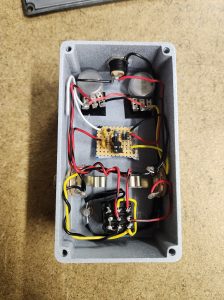 This was a really simple pedal build and I managed to knock it out quickly on a Saturday afternoon. There’s really nothing too tricky here to deal with.
This was a really simple pedal build and I managed to knock it out quickly on a Saturday afternoon. There’s really nothing too tricky here to deal with.
The being said, it’s a standing rule that it’s impossible to build a guitar pedal without anything going wrong, and they never work the first time when you plug them in to test them. In this case, I forgot to put the transistor into the socket, so of course it didn’t work the first time.
I did end up using different diodes than what was in the schematic. I used 1N4001 because I couldn’t track down the 1N4148. It probably wasn’t the best swap out there, but they’re what I had available and the pedal still sounds great.
If you’re a new guitar pedal builder who wants to make something a bit different, the Green Giant would be a good choice. There’s so few components to the build that you’re unlikely to make a mistake, and it’s a bit of a weird pedal to add to the collection.
How Does The Greer Amps Green Giant Sound?
The Green Giant is a really interesting sounding pedal.
Firstly, the odd thing about the pedals design is that the amount of distortion coming through increases as you turn the clean mix knob to the left. It’s usually the other way around, however, this is by design! I mentioned that this circuit doesn’t actually have a way to increase the gain. Instead, there’s a set amount of gain going through the circuit, and the clean mix pot simply determines how much of the guitar signal is going through the clipping diodes. So, in a lot of ways, the effect that you’re producing is turning down the distortion, hence why turning the pot to the right decreases the amount of distortion coming through. That’s the logic in my mind at least…
With all of this, the clean mix knob is what it sounds like. It’s not a level of distortion, but rather a mix. This creates layers of sound. Turned all the way to the left, there’s no resistance for the clipping diodes and the only layer is distortion. Turned all the way to the right, the clipping diodes are completely removed and the only layer is (mostly) clean. In the middle you get a layer of distortion and a layer of dirt. Adjust left or right as you see fit.
It’s all a pretty smooth distortion sound with little crunch to it, which feels pretty typical of the Electra Distortion circuit (in my experience at least). This pedal is more suited to Country and Blues than it is Metal and Punk. I’d use this pedal to thicken up a sound.
Related posts:
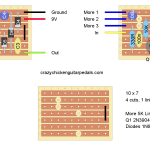 EartherQuaker Devices Speaker Cranker On Stripboard
EartherQuaker Devices Speaker Cranker On Stripboard
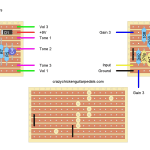 Lovepedal Purple Plexi On Stripboard
Lovepedal Purple Plexi On Stripboard
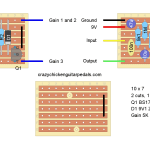 ZVEX Super Hard On On Stripboard
ZVEX Super Hard On On Stripboard
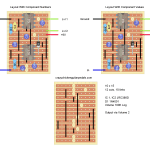 EarthQuaker Devices Acapulco Gold On Stripboard
EarthQuaker Devices Acapulco Gold On Stripboard
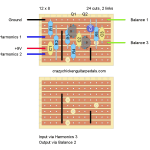 Escobedo Harmonic Jerculator On Stripboard
Escobedo Harmonic Jerculator On Stripboard
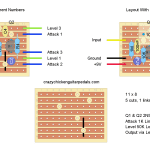 Vox Tone Bender On Stripboard
Vox Tone Bender On Stripboard
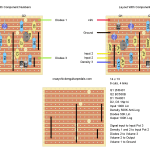 Catalinbread Karma Suture On Stripboard
Catalinbread Karma Suture On Stripboard
 Colorsound One Knob Fuzz On Stripboard
Colorsound One Knob Fuzz On Stripboard
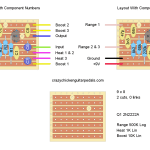 Catalinbread Naga Viper On Stripboard
Catalinbread Naga Viper On Stripboard
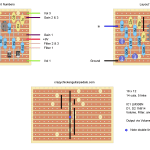 ProCo Rat On Stripboard
ProCo Rat On Stripboard
